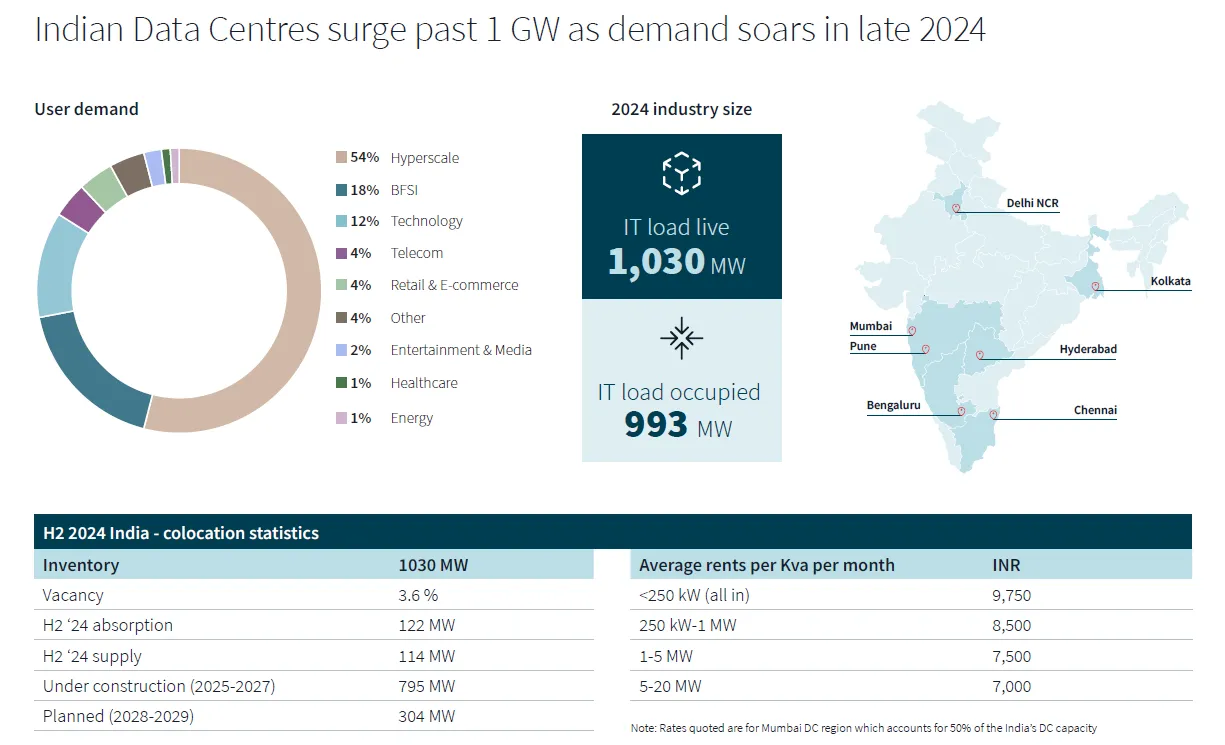India’s Data Centre Boom: Growth, Challenges, and the Road Ahead
Explore India’s booming data centre industry — growth trends, key investments, challenges like energy and water use, and the policy roadmap for sustainable expansion. Relevant for UPSC GS Paper III & II.
Context
A recent Macquarie report (October 2025) highlights India’s rapid data centre expansion, led by Mumbai, which accounts for nearly 45% of current capacity. India’s total data centre capacity is expected to double by 2027. However, this boom comes with significant challenges in terms of energy demand, water use, and regulatory hurdles that could shape the future of India’s digital infrastructure.

What are Data Centres?
Definition: Data centres are physical facilities that store, process, and manage digital data and IT operations. They house servers, networking systems, and cooling infrastructure that enable round-the-clock functioning of digital platforms.
They form the core of the digital economy, supporting cloud computing, AI processing, streaming platforms, fintech, and e-governance systems. As India transitions into a data-driven economy, these centres serve as the “engines” that power digital services used by citizens, governments, and businesses.
Why is their Importance Increasing?
1. Digital Transformation and Cloud Adoption
The expansion of 5G networks, Artificial Intelligence (AI), and the Internet of Things (IoT) has triggered an unprecedented surge in data generation.
Major global tech players such as Amazon Web Services (AWS), Google, Microsoft, and TCS are investing billions to expand India’s data capacity. The rise of AI-driven industries, smart manufacturing, and cloud-based enterprises has made data centres indispensable to national competitiveness.
2. Data Localisation Mandates
Under the Digital Personal Data Protection Act, 2023, sensitive and critical data of Indian citizens must be stored within the country. This policy framework has accelerated the construction of domestic data centres, aligning digital security with national sovereignty and creating vast investment opportunities.
3. Economic and Strategic Significance
Data centres are emerging as the “factories of the digital economy”, facilitating AI research, fintech innovation, and smart city projects.
They generate employment across allied industries — renewable energy, HVAC systems, power management, and hardware manufacturing — and attract large-scale Foreign Direct Investment (FDI) inflows.
4. Growing Regional Footprint
As of 2025, India’s operational capacity stands at 1.4 GW, with another 1.4 GW under construction and 5 GW in the pipeline.
-
Mumbai (45%), Chennai (18%), and Delhi-NCR (11%) dominate capacity distribution.
-
Major Investments include:
-
Google: $15 billion AI hub in Visakhapatnam (with Adani Connex and Airtel)
-
Amazon Web Services: $12.7 billion expansion by 2030
-
Reliance Industries: 3 GW hyperscale centre at Jamnagar
-
TCS: $6.5 billion investment for 1 GW capacity
-
What are the Major Challenges?
1. High Energy Demand
Data centres are energy-intensive, consuming vast amounts of electricity for both computation and cooling. In 2024, they accounted for 0.8% of India’s total electricity demand, projected to reach 1.9–3.2% by 2030 (S&P Global, 2025).
Power reliability remains uneven across states, posing risks to uptime and operational continuity.
2. Water Usage for Cooling
Cooling systems require around 25 million litres of water annually per megawatt load, raising sustainability concerns.
Cities like Mumbai, Chennai, and Bengaluru, which already face seasonal water scarcity, could experience further strain unless alternative cooling technologies such as liquid immersion cooling, air-based systems, or recycled water mechanisms are adopted.
3. Regulatory and Policy Bottlenecks
India’s National Data Centre Policy (2020) remains in draft form. Operators often require 30–40 clearances from multiple ministries for land, power, and environmental permissions.
Fragmented state-level policies — such as those in Maharashtra, Tamil Nadu, and Uttar Pradesh — create inconsistencies in tax incentives and infrastructure support, discouraging faster rollouts.
4. Land and Infrastructure Constraints
Data centres need large, stable land parcels with strong connectivity and disaster resilience. However, restrictive land laws and long approval processes slow progress, especially in Tier-2 and Tier-3 cities where expansion is most needed.
5. Dependence on Imports
India imports most of its mechanical, electrical, and IT equipment — including server racks, cooling systems, and power backups — which increases project costs and dependence on foreign suppliers. This dependence limits the Atmanirbhar Bharat vision and slows domestic value-chain development.
The Way Forward
To sustain its data centre growth, India must adopt a holistic and sustainable policy framework:
-
Finalise the National Data Centre Policy with integrated planning for land, power, and water.
-
Promote local manufacturing under Make in India for critical hardware components.
-
Encourage green and renewable-powered data centres to align with carbon neutrality goals.
-
Establish single-window clearance systems and incentivise water-efficient technologies.
India’s data centre expansion represents both an economic opportunity and an environmental test. Ensuring sustainable energy use, efficient water management, and simplified regulations will determine whether this digital boom can power India’s long-term growth securely and responsibly.
Subscribe to our Youtube Channel for more Valuable Content – TheStudyias
Download the App to Subscribe to our Courses – Thestudyias
The Source’s Authority and Ownership of the Article is Claimed By THE STUDY IAS BY MANIKANT SINGH





